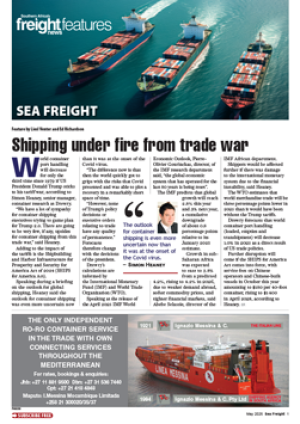Developing bulk freight linkages across southern Africa forms a large part of railway construction projects in the region, totalling more than $53 billion, with almost all of it connected to one objective – getting copper out of the Democratic Republic of the Congo (DRC).Some of the projects dominate talk when sub-Saharan logistics is under discussion, such as the 923-metre bridge built at a cost of R3.9 billion south of Kazangula in Zambia.Once in use, expectedly later this year, trucks will no longer have to use ferries in crossing the Zambezi where the Chobe f lows into it.Kazungula’s one and only engineering marvel is also pivotal to plans for the construction of a 430-kilometre railway line between Botswana and Zambia with an anticipated price tag of $259 million.But it’s the emergence of sleeper developments, long-since mooted and forgotten or placed on ice for whatever reason, that is really adding interest to the bulk freight picture developing across the Southern African Development Community (SA DC).One of these, often mentioned in lesser terms than the Kazungula Bridge and other linkages holding popular sway, is the Benguela Corridor between Angola and the DRC’s southern tip.According to Roelof van Tonder of Africa House, “the Angolans are making a big push to link the Port of Lobito with the copper belt.“The DRC is absolutely f looded with minerals that will sustain renewable and climate-friendly economies and you’re not just talking about copper. It’s nickel, cobalt and other minerals with strong energy-storing capacity.”The director for market insight and development at the trade consultancy says the railway line, built during Belg ium’s colonial rule, is still in place from the copper mining nerve centre of Kolwezi to Dilolo near the DRC’s border with Angola.Also in place is the line from Lobito to Luau, the last town on the Angolan side of the border before.If they connect Dilolo and Luau, some 15 kilometres apart, there is no reason why bulk ore on the Benguela Corridor shouldn’t increase.The port at Lobito has capacity issues but manganese, Van Tonder says, is already being stock-piled and trucked across the border.Further south, and contingent on establishing a bulk line through its north-eastern panhandle, is Namibia’s existing rail connection between the Port of Walvis Bay and Grootfontein. The Walvis Bay Corridor Group (WBCG) has on several occasions indicated that extending the rail link through the Caprivi, nowadays also referred to as Zambezia, enjoys primacy as far as its logistical ambitions are concerned.Should the Benguela Corridor come on line though, it could prove a real volume spoiler for the WBCG, such is the copper belt proximity advantage it holds over Namibia.Directly to the east of the SADC are yet more rail linkage developments involving ports like Nacala in Mozambique and Dar es Salaam in Tanzania.Instrumental in these infrastructural exercises is China, mapping out an intricate network of main lines and spurs that spreads through northern Mozambique, Malawi and links up with the Tazara line connecting Tanzania and Zambia.The main purpose of this development would be to get to Zambia’s share of the copper belt’s ore.According to van Tonder, an extensive rail network across the entire region would be required for Africa to meet growth targets and progressively adhere to the global megatrends of shifting wealth, the rise of emerging economies, demographic and urban transition, 4th industrial revolution dynamics and climate change challenges.“If you look at the main opportunities I cannot look at a single one that will not require some kind of rail intervention for any of these megatrends to become sustainable.”
INSERT: The DRC is absolutely flooded with minerals that will sustain renewable and climate-friendly economies.– Roelof van Tonder

